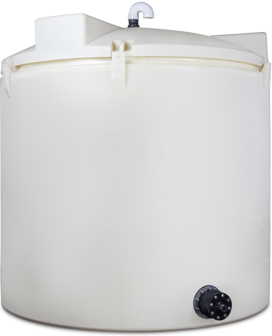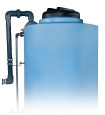Evaluating Your Containment Costs: SAFE-Tanks vs Concrete Secondary Containment
.jpg?width=1200&height=630&name=Evaluating%20Your%20Containment%20Costs%20SAFE-Tanks%20vs%20Concrete%20Secondary%20Containment%20(1).jpg)
Secondary containment systems are recommended and more andmore required safeguards that can prevent costly damage to equipment and risk to employees if a primary storage vessel is breached.
There are several secondary containment options with varying costs, and concrete containment is a popular industry standard. But you may be surprised when you compare the true costs of a poured in place concrete system to Poly Processing’s sophisticated, integrated, double wall tank containment system, the SAFE-Tank®.
The True Cost of Concrete Containment
Many companies only consider the initial costs of a concrete secondary containment system, but there are ongoing costs and maintenance costs to consider as well. Here are a few factors you should consider before purchasing a concrete containment.
Multiple Containment Areas
If you’re storing various chemicals—especially acids and bases—you’ll need separate containment areas for each type of chemical. This prevents the possibility of a hazardous reaction if two leaks occur at the same time. While it adds a layer of protection, it also adds costs, square footage, and complications. Not only do you need to invest more, financially, but you also need to have adequate space for containment. And multiple containment areas means more man-hours for maintenance.
Cost of Concrete
Concrete can cost up to $12 per gallon or more, depending on the type of coating that’s used. Since a secondary containment tank must be able to hold 110% to 120% of the primary tank, just the secondary containment for a 1000-gallon tank could cost upwards of $12,000 or more. That does not even factor in the cost of the primary tank.
Read more: Cost of Not Having a SAFE-Tank
Coating and Maintenance
The inside of the concrete containment must be coated to keep chemicals from etching through the concrete. If etching occurs, you may need to repair or re-line the concrete system.
Even functioning concrete containers need to be recoated on a regular basis. Weathering from rainwater and exposure to the elements eventually wears out the coating. This process involves entering the containment area and thoroughly cleaning it, and applying a new barrier to the concrete. It’s an involved process that requires project management, proper staffing, and budgeting.
Leak Detection
Concrete containment areas normally require leak detection in the interstitial space to monitor the integrity of the storage unit at all times. However, sensors in the concrete containers can get wet due to rainwater, and signal a false positive.
Chemical Spills
If a spill does occur into a concrete secondary containment, in most cases you won’t be able to recover the chemical and reuse it. The chemical will become contaminated and you will need to:
- Remove or haul away the spilled chemical
- Purchase a replacement supply of chemical
- Repair, recoat, or replace the concrete container
SAFE-Tanks Save Money and Improve Containment
By contrast, SAFE-Tanks help you trim your costs and increase efficiency. Here are several advantages of a SAFE-Tank.

The SAFE-Tank containment and storage system functions as a "tank within a tank," otherwise known as a double-walled tank system. Since it is built from high density cross-linked polyethylene that is capable of holding the chemical without issue, there is no need to designate a large area for a concrete containment structure. In the case of a spill, the risks of damage or lost product is mitigated with very little downtime.
The value of a SAFE-Tank includes a naturally built-in 110 percent secondary containment tank without compromise to chemical quality in case of a spill. Even if there is damage to the inner tank, the tank works to equalize the liquid level and can be used until the chemicals inside have been depleted. It essentially becomes a single wall tank at this point until repaired. This means tank repairs are not emergencies, saving you critical time and money.
The dome structure of a SAFE-Tank prevents water and debris from entering the containment tank due to its mushroom like design, which eliminates the risk of false positives for leak detection. The SAFE-Tank also offers spurt-protection due to the completely encased sidewall, which mitigates the risk of an injured employee possibly getting chemical sprayed on them.
The SAFE-Tank can be double wall piped from the tank to wherever you want the pipe to terminate using the industry’s only true double wall transition fitting. This important fitting drains the primary tank through the containment tank while acting as a secondary containment around the fitting. You can mount a 6” flange to the outside of the transition fitting and run double wall piping while keeping everything fully contained.
Save Space
Only one tank pad is needed. And because any spills are self-contained, you can store acids and bases right next to each other.
No Coatings
The SAFE-Tank is made of cross-linked polyethylene, eliminating the need for additional coatings or re-coatings. SAFE-Tanks are maintenance-free.
Leak Detection
With the SAFE-Tank, you don’t have to worry about leak detector false positives, because rainwater can’t enter the interstitial space. If the primary tank leaks the operator can use up the chemical and decide when they want to repair the tank.
Reuse the Chemical
SAFE-Tank won’t allow any debris or dirt to get into a spilled chemical. You can easily retrieve the spilled chemical and reuse it. If you’re storing expensive chemicals, this could save a lot of money.
Save Time
Maintenance-free storage means that you’ll save valuable time and hassle, freeing up your staff for more important work.
Not Having a SAFE-Tank Is Not Worth It
In the event of a chemical spill or naturally occurring contamination from rainwater or debris, the cost of containment, such as a concrete basin or an open-top system, can well exceed the cost of a SAFE-Tank. Proper disposal of leaked or contaminated chemicals includes the rental of a tanker truck, which can range from $5,000 to $10,000 or more depending on a customer's geographic location and chemical being stored.
With an open-top tank or concrete system, total loss of all contained chemicals is typical. The cost of replacement chemicals can range from $1 to $10 per gallon or more for organizations buying in bulk.
Altogether, the SAFE-Tank can cost up to 90% less than traditional concrete containment structures. Contact Poly Processing to learn more about how the SAFE-Tank system can help you make containing your chemicals less expensive.
For more information about SAFE-Tanks, download the SAFE-Tank guide below.
- May 11, 2017
About Poly Processing
Posts By Topic
Tech Talk Podcast Episodes
Subscribe By Email
Recent Posts
- Maximizing Fill Efficiency: Selecting the Optimal Fill Line System
- Chemical Storage Tanks: A Quick Guide for End Users
- Popular Customization Options for Chemical Storage Tanks
- Understanding Flood Zones Under the IBC: Building Requirements and Insurance Implications
- Choosing Between Steel, Polyethylene, and Fiberglass Tanks: What You Need to Know
Tank Configurator

Find the recommended tank and system components for your chemical storage challenge.
Configure a Tank Package



